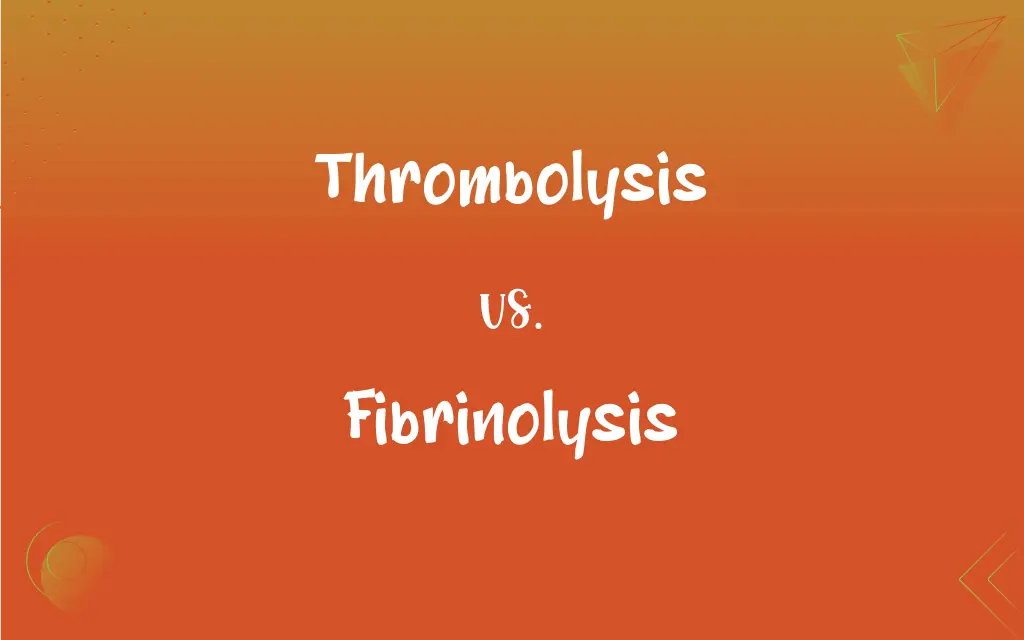Thrombolysis vs. Fibrinolysis: What's the Difference?
Edited by Aimie Carlson || By Janet White || Published on February 16, 2024
Thrombolysis is the breakdown of blood clots (thrombi), while fibrinolysis is the specific process of dissolving fibrin, a key protein in clot formation.

Key Differences
Thrombolysis refers to the medical treatment and natural process of dissolving thrombi or blood clots, which can obstruct blood vessels. Fibrinolysis, a subset of thrombolysis, specifically involves the breakdown of fibrin, the protein strands that give clots their structure.
Thrombolysis is crucial in medical emergencies like heart attacks and strokes, where rapid dissolution of clots can save lives. Fibrinolysis, on the other hand, is a continuous physiological process maintaining vascular health by preventing excessive clot formation.
In thrombolysis, drugs known as thrombolytics are administered to dissolve clots. In contrast, fibrinolysis involves the action of enzymes like plasmin, which specifically target and break down fibrin.
Thrombolysis can be seen as the broader concept encompassing all aspects of clot breakdown. Fibrinolysis is an integral part of this, focusing on one specific aspect - the degradation of fibrin.
Understanding the difference is crucial in medical contexts, as targeted therapies might aim for general thrombolysis or specific fibrinolysis, depending on the condition and the nature of the clot.
ADVERTISEMENT
Comparison Chart
Definition
Breakdown of blood clots
Specific breakdown of fibrin in clots
Scope
Broad, encompasses all types of clot dissolution
Narrow, focuses on fibrin
Physiological Role
Clears obstructed vessels, restores blood flow
Continuous process maintaining vascular health
Medical Use
Used in emergencies like strokes
Integral part of overall clot management
Key Agents
Thrombolytic drugs
Enzymes like plasmin
ADVERTISEMENT
Example
Administering tPA to dissolve a clot in the brain
Plasmin breaking down fibrin strands in a healing wound
Thrombolysis and Fibrinolysis Definitions
Thrombolysis
It's a natural process aiding in clot resolution.
The body's thrombolysis mechanism prevented the clot from growing.
Fibrinolysis
Fibrinolysis is the breakdown of fibrin in blood clots.
Fibrinolysis is critical in the wound healing process.
Thrombolysis
Thrombolysis is the medical process of dissolving blood clots.
The patient received thrombolysis to treat their stroke.
Fibrinolysis
It's a specific component of the body's clot management system.
Effective fibrinolysis prevents excessive clotting.
Thrombolysis
It's the breakdown of thrombi in the body.
Thrombolysis restored blood flow to the affected area.
Fibrinolysis
It's a continuous physiological process preventing clot persistence.
Fibrinolysis balanced clot formation after the surgery.
Thrombolysis
Thrombolysis is essential in acute cardiovascular treatments.
Emergency thrombolysis was initiated upon the patient's arrival.
Fibrinolysis
Fibrinolysis involves enzymes like plasmin targeting fibrin.
Plasmin's role in fibrinolysis helps maintain blood flow.
Thrombolysis
Thrombolysis involves using drugs to disintegrate clots.
Immediate thrombolysis can be life-saving for heart attack patients.
Fibrinolysis
Fibrinolysis is crucial for vascular health and integrity.
Impaired fibrinolysis can lead to abnormal clotting issues.
Thrombolysis
Dissolution or destruction of a thrombus.
Fibrinolysis
The breakdown of fibrin, usually by the enzymatic action of plasmin.
Thrombolysis
The breaking down of blood clots by pharmacological or other means.
Fibrinolysis
The process wherein a fibrin clot, the product of coagulation, is broken down.
Thrombolysis
The process of breaking up and dissolving blood clots
Fibrinolysis
A normal ongoing process that dissolves fibrin and results in the removal of small blood clots;
Drugs causing fibrinolysis have been utilized therapeutically
FAQs
What is fibrinolysis?
It's the specific breakdown of fibrin, a key component in blood clots.
When is thrombolysis used?
In medical emergencies like strokes or heart attacks to dissolve clots.
What is thrombolysis?
It's the process of dissolving blood clots in the body.
Can thrombolysis be used for deep vein thrombosis?
Yes, it's one of the treatments for significant deep vein thrombosis.
Are there risks associated with thrombolysis?
Yes, including bleeding and allergic reactions.
How does fibrinolysis work?
Through enzymes like plasmin that specifically break down fibrin.
Are thrombolysis and fibrinolysis the same?
No, fibrinolysis is a specific part of the broader thrombolysis process.
What drugs are used in thrombolysis?
Drugs like tPA (tissue plasminogen activator) are commonly used.
Is fibrinolysis a continuous process?
Yes, it continuously works to maintain normal blood flow and prevent excessive clotting.
Can anyone receive thrombolytic therapy?
No, it's contraindicated in certain conditions due to the risk of bleeding.
How are thrombolysis and fibrinolysis monitored?
Through clinical observation and blood tests measuring clotting times.
What conditions might impair fibrinolysis?
Conditions like liver disease or certain genetic disorders can impair it.
What role does plasmin play in fibrinolysis?
Plasmin is the enzyme that directly breaks down fibrin.
How quickly must thrombolysis be administered?
Ideally within a few hours from the onset of symptoms for maximum effectiveness.
Is ongoing treatment needed after thrombolysis?
Often, additional treatments like anticoagulants are needed to prevent further clotting.
How is fibrinolysis related to wound healing?
It helps by breaking down clots that form as part of the healing process.
Can thrombolysis fail to dissolve a clot?
Yes, particularly if the clot is old or the treatment is delayed.
What are signs of successful thrombolysis?
Improved symptoms and blood flow, confirmed by imaging or tests.
Does fibrinolysis have any side effects?
Abnormal fibrinolysis can lead to either excessive bleeding or clotting.
Can lifestyle affect fibrinolysis?
Yes, factors like diet, exercise, and smoking can influence it.
About Author
Written by
Janet WhiteJanet White has been an esteemed writer and blogger for Difference Wiki. Holding a Master's degree in Science and Medical Journalism from the prestigious Boston University, she has consistently demonstrated her expertise and passion for her field. When she's not immersed in her work, Janet relishes her time exercising, delving into a good book, and cherishing moments with friends and family.
Edited by
Aimie CarlsonAimie Carlson, holding a master's degree in English literature, is a fervent English language enthusiast. She lends her writing talents to Difference Wiki, a prominent website that specializes in comparisons, offering readers insightful analyses that both captivate and inform.







































































